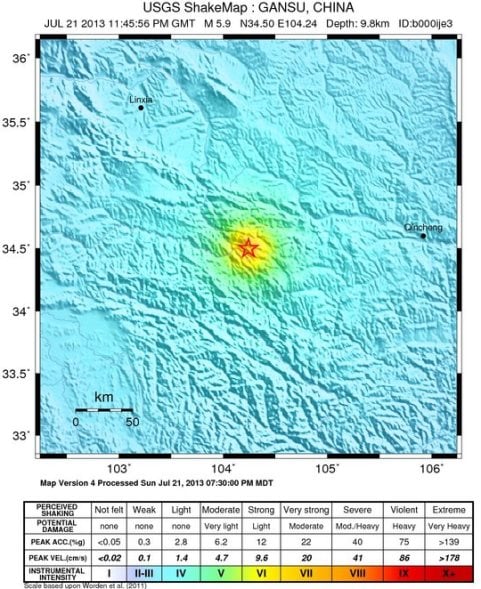Northwestern China Earthquake
Status: Closed
| Type of posting | Posting date(EST): | Summary | Downloads |
|---|---|---|---|
| First Posting | 7/22/2013 12:45:00 PM |
|
First Posting | Summary
Posting Date: July 22, 2013, 12:45:00 PM
Rural communities in northwest China 1,233 km (766 mi) WSW of Beijing experienced a devastating earthquake on July 21 at 23:45:56 UTC (July 22, 7:45 a.m. local time). At least 89 people were killed, more than 400 were injured, and in Zhang County an estimated 27,360 people have been left homeless.
The magnitude of the earthquake has been estimated as 6.6 by the China Earthquake Data Center, 5.9 by the United States Geological Survey, and 6.0 by the European Alert System. Tremors were felt in the provincial capital of Lanzhou 177 km (110 mi) north, and as far away as Xi'an, 400 km (250 mi) to the east. It was a shallow event, occurring at a depth of about 10 km (6 mi), and has been followed by a series of at least seven aftershocks, including one of 5.6 magnitude.
The event occurred in the west Qingling Mountain Range in Gansu Province. The epicenter is about 230 km (143 mi) north-northwest of the Longmenshan fault, which ruptured during the 2008 Mw 7.9 Wenchuan earthquake. It falls within the North-South Seismic Belt in central China. The tectonics of the epicentral area are poorly understood because of its mountainous topography. Several large earthquakes, including two events of magnitude 8 in 1654 and 1879, were located within 150 km (93 mi) of this event. But none of these large events have been associated with any mapped active faults, and none of the active faults in this area have been mapped well enough to provide insight into the seismogenic activities in this region.
Reported Impacts
According to the Xinhua News Agency, eight towns in remote and mountainous areas have been seriously damaged in the earthquake and the flooding and mudslides that followed. Landslides have blocked the major railway linking Longxi County and Tianshui City and several roads, cutting off 13 townships and obstructing rescue and recovery work. The continuing heavy rain in the region is also hampering rescue operations and increasing the need to provide shelter.
Telephone service to many communities was cut and over 14,000 households lost their power supply. Hundreds of troops have been sent to the area to aid rescue operations and the Chinese Red Cross has sent 200 tents, 1,000 sets of household items, and 2,000 jackets as well as teams of rescue workers from Lanzhou and Beijing.
Exposure at Risk
The rupture occurred in an arid and hilly farming area on the border of Minxian County and Zhangxian County in the city of Dingxi. This is a lightly-populated region of mountains, desert and pastureland. The agricultural area around Dingxi however, which is about the size of New Jersey, has rolling hills terraced for crops and fruit trees and a more concentrated population of about 2.7 million.
Gansu is one of the poorest provinces in China, and it has many old buildings, typically of adobe or unreinforced masonry (brick) with tiled roofs. Structures of this type are highly vulnerable to ground shaking. Gansu Television reported that 20% of buildings in the earthquake-stricken zone have collapsed and that 60% show cracks. The Dingxi city government website claims that nearly 2,000 homes have been badly damaged or destroyed. Residents of Dingxi reported however that the shaking there lasted about one minute, and wasn't strong enough to cause major damage in urban areas, where buildings are more solidly constructed.
Insurance Impact
Because of its low population and agricultural economy, there is little exposure in this province and insurance take-up rates are low. While damage is likely to be serious and potentially widespread, AIR does not expect significant insured losses from this event.
ShakeMap of the M5.9 Gansu Province Earthquake of July 22, 2013 (Source: USGS)